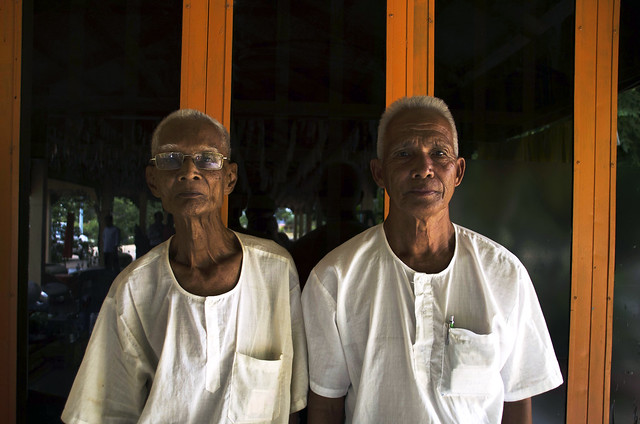The silence in the pagoda is almost deafening. Under a clutch of trees a group of children are playing but they seem to make only a little more noise than the long lengths of tangerine fabric hanging to dry in the breeze, and they disappear soon after we arrive.
In Cambodia it is difficult to reconcile the pristine peace of the countryside with the upheaval that transpired during the Khmer Rouge era in these same places forty years ago. This reconciliation process is, in its most tangible form, taking place in the Extraordinary Chambers in the Courts of Cambodia. Most importantly it is occurring for the benefit of the people of Cambodia, and so a crucial part of the court’s work is to reach out to those who lived through the Khmer Rouge regime as well as the following generations. Therefore on days when no hearings are taking place, the public affairs team travels to the rural areas to distribute literature and discuss the work of the court with communities there.
The most effective way to reach people is to target pagodas and schools. In Kampong Speu province the team spoke to several leaders of pagodas as well as groups of monks, explaining how the court works, what it’s accomplished thus far, what cases it’s currently working on and the reasons why its existence is so important for reconciling Cambodia as a country with the brutalities in its past.
This work becomes all the more meaningful when we encounter people who themselves lived through the Khmer Rouge regime.
Pich Vin is eighty years old. His skin is the deep, warm brown of a chestnut, and instead of wrinkling with age he seems to have shrunk, so the bones in his face and neck and hands jut sharp and clean like the edges of knives. In the sunlight filtering through the frangipani trees over his long white linen shirt his face is peaceful: it is easy to imagine him as the monk he was before the Khmer Rouge took Phnom Penh in 1975. A week after they arrived, he says, he was forcibly defrocked and evacuated to his home village in Takéo province, in the Prey Kabbas district.
During the regime Vin was classified as part of the New People, or 17 April People. As such he was part of a mobile force and made to work. In late 1978, just a few months before the fall of the Khmer Rouge, he says he was forced to marry a woman six years his junior. Although for many years they had lived just three kilometers away from each other, they had never met prior to their wedding day. He did not have a choice, he said – he felt it was either marry this woman, or be killed.
After the Khmer Rouge fell he stayed with his wife. They were in the fortunate position of finding mutual respect for one another, and they remained together until her death a few years ago. She had two children from a previous marriage, who he took in as his own, and together they had one child.
Vin never went back to being a monk. Instead he lives out his days in the Wat Ant Metrey pagoda, occasionally listening to the doings of the court via radio. He believes the court is a good thing for the country. The Khmer Rouge divided the people, he said. They need to pay for the wrongs they did to people, and the ECCC provides a way for them to do so. The role it plays in reconciliation, in reunification, is crucial.
Beside him on the low bench under the frangipani trees sits his friend, Meas Sokhom. At seventy years of age, Sokhom is a little younger than Vin and although his skin is the same smooth warm brown, his wrinkles have not dug so deep yet, and his movements are more energetic when he talks about his life under the Khmer Rouge.
Sokhom left his home province of Takéo in 1975, just after the Khmer Rouge seized power. Like Vin, he didn’t see himself as having a choice: if he stayed, he says, the Khmer Rouge would have killed him because of his background as a soldier in the Lon Nol army.
Instead he ran north to the rice fields in the Samraong Tong district in Kampong Speu province. By taking on the role of a farmer – as well as pretending to be insane – Sokhom was able to stay alive for the duration of the regime. He moved around a great deal during those four years. Whenever he learned a new task, like making fertilizer or harvesting rice, the Khmer Rouge would move him to somewhere else, where he’d then have to start all over again and learn a new task. After the 1979 defeat of the Khmer Rouge, he stayed in Kampong Speu, in the pagoda where we met him.
He believes that the Khmer Rouge Tribunal is overall good for the country and will provide some justice –the Khmer Rouge should be punished for destroying so many people’s lives, Sokhom says. Along with the others in the pagoda, he follows the doings of the court by radio.
The calm and quiet of life for these two in the pagoda is a far cry from hardships endured during the Khmer Rouge regime. But this discrepancy between then and now is an important reminder why the outreach and the spread of knowledge about the court is so crucial: reconciliation is a part of the healing process, and without people like Vin and Sokhom that reconciliation is missing the link it needs between past and present.
